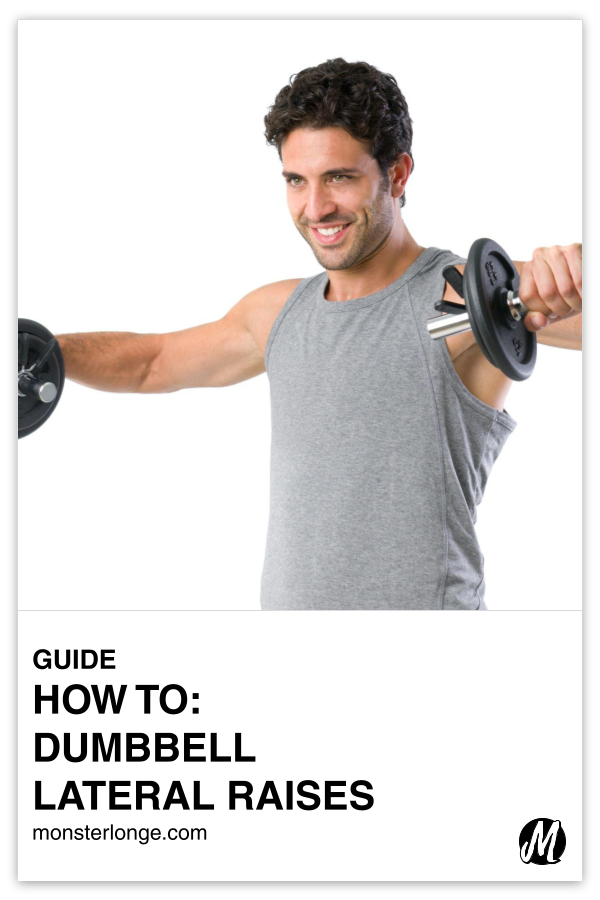
How To: Dumbbell Lateral Raises
Dumbbell lateral raises are an exercise that target the medial deltoid.1Lateral raises are also called side lateral raises but since “side” is another word for “lateral”, calling them by that name is as stupid as saying chai tea or naan bread.
Why the fuck would you want to target the medial deltoid?, you ask. Plus, what the fuck is a deltoid in the first place?!?!
Ha!
The deltoids, or delts, are a muscle group in the shoulder that help lift the arm. More specifically, the muscle group consists of three heads.2A “head” is a point of origin, which is where the muscle attaches to a bone and doesn’t move when contracted. Conversely, an insertion is the other end of the muscle that’s attached to a bone that moves when the muscle shortens. These are the anterior, posterior, and medial delts. Training each serves a different benefit but targeting the medial, or lateral, delt in particular is what makes the shoulders wider and rounder. In addition to improving your appearance by broadening your shoulders, development of the medial delts also has the illusory effect of making the waist look smaller.
So yeah, that’s why you would want to target the medial deltoid.
And yeah, that’s why you would want to perform dumbbell lateral raises to do so!
INSTRUCTIONS
1). Grab a pair of dumbbells and hold them down at your sides with your feet shoulder-width apart and a soft bend in your knees.3The provided instructions are for the execution of the exercise standing up but the movement can also be performed sitting down. To do so, grab a pair of dumbbells and sit up straight on the edge of a flat bench with your legs together and feet flat on the ground. Lean forward at the hips and hold the dumbbells down at your sides with your palms in neutral, or facing each other. The rest of the instructions are the same from step #3 onward.
2). Hinge over at the waist slightly and rotate your hands so the dumbbells are pointing at an angle in front of your hips.
3). Squeeze your glutes and retract your scapula.4Retract your scapula by pushing your shoulder blades back and then down like you’re tucking them into the back pockets of your jeans.
4). With a slight bend in your elbows and while keeping your chest up, brace your core and breathe out as you raise your arms away from your body in the shape of a “W” until they’re shoulder level and your palms are facing the floor.5A “W” shape means your arms shouldn’t be directly to the side of your body at the top of the movement nor should they be straight in front of you. Instead, your arms should be somewhere between those two points. If you’re a geometry wiz, the angle we’re looking for is about 20-30 degrees in front of you.
5). Pause for 1-2 seconds.
6). Breathe in as you slowly lower your arms to the starting position.6Don’t lower your arms all the way down so they make direct contact with your body at the bottom of the movement. That will take stress off the deltoids. Instead, allow your arms to hover about an inch or so away from your sides and maintain tension.
7). Pause for 1-2 seconds before proceeding to the next rep.
NOTE (1): It’s important to execute the movement without shrugging your shoulders. Resist the urge to raise your shoulders, particularly the traps, before raising the weight. Your shoulders should remain back and down throughout the movement.
NOTE (2): It’s also important to execute the movement without the use of momentum. There should be no rocking back and forth of your body to lift the weight. If so, then the weight is too heavy!
NOTE (3): To ensure that you’re lifting the weight with your delts and not your arms, don’t choke up on the dumbbells. Instead, have a loose grip and think about moving your arms away from your body with your elbows rather than with the use of your entire arm.
For a workout routine that possibly includes dumbbell lateral raises, as well as other exercises geared specifically to your goals, training experience, injury history, and available equipment, then find out more HERE
Glossary: arms, bench, chest, dumbbell, exercise, glutes, goal, muscle, muscle group, routine, traps
